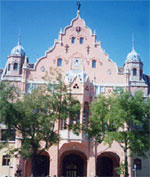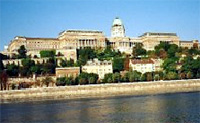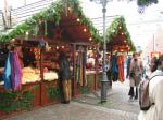|
|
|
|
Top Hungary Destinations:
Budapest hotels Hajduszoboszlo hotels Heviz hotels Szeged hotels Siofok hotels See more hotels in Hungary
World Destinations:
 Guides » Hungary » Hungary - Spending Time in Eastern Europe Guides » Hungary » Hungary - Spending Time in Eastern EuropeHungary - Spending Time in Eastern Europe
While there are many beautiful places to visit in the world, a trip to Hungary is truly a special treat, the perfect place to enter Eastern Europe. Although most tourists head to Budapest, keep in mind that Hungary offers a number of fine cities worth visiting. However, in the city of Budapest, you will find charming cafes, lively arts, and an incredible music scene. In addition, the city boasts a number of sporting and cultural festivals throughout the year.
Outside of Budapest, you will discover another world of beautiful lakes with lovely resorts lining the shores, Baroque towns, backcountry villages, and wide, open plains. Whether going to Hungary to enjoy the countryside, relax in a natural, thermal spa, bird watch, or sample any number of exquisite wines, most people fall in love with the country immediately. Today, more than 10 million people live in Hungary with about 20% of those in the capital city of Budapest. The population is quite diverse, consisting of a unique blend of Hungarian, German, Romanian, Slovak, and Gypsy.  The country itself lies in the Carpathian Basin, which has been populated for thousands of years. The area was originally reached during the mid-8th century by nomadic named Magyars. As skilled equestrians, they would raid the country until 955 when the Germans stopped them. Left in dismay at being defeated, they were eventually forced to join allies with the Holy Roman Empire. However, in 1000, the prince, Stephen, was crowned as the Christian King Stephen I and with a crown from the Roman Pope, Hungary to include the kingdom and nation was born. The country itself lies in the Carpathian Basin, which has been populated for thousands of years. The area was originally reached during the mid-8th century by nomadic named Magyars. As skilled equestrians, they would raid the country until 955 when the Germans stopped them. Left in dismay at being defeated, they were eventually forced to join allies with the Holy Roman Empire. However, in 1000, the prince, Stephen, was crowned as the Christian King Stephen I and with a crown from the Roman Pope, Hungary to include the kingdom and nation was born.
Stephen’s first project was to consolidate all of the royal authority by seizing the land. Then, he developed a system of counties and began promoting the countryside. When he died in 1038, Hungary was westward looking and a country of multiple ethnics. For the next 250 years while under the rule of the House of Arpad, the new kingdom faced challenges. Constant struggles between rival claimants to the throne broke out and power-hungry neighbors began snatching up land. It was only after Andrew II died in 1301 that the country’s descent into anarchy was stopped. At that time, the country started to flourish, which was followed by a number of able-minded rulers. However, Hungary’s army was crushed in 1526 by Ottoman Turks in the Battle of Mohacs, bringing defeat and marking the end of an independent and prosperous country. As you can imagine, Hungary was sent into a tailspin and with Turkish occupation, the country did not improve. However, the Hungarian people resisted the Turkish rule and in 1699, the Turks were forced out. Rather than see a new and improved independent country, Hungary fell under the province of the Austrian Habsburg Empire, which helped Hungary to grow economically and culturally, along with nationalism. Again, Hungary declared full independence in 1849 and insisted on the Habsburgs being dethroned. Unfortunately, the Habsburgs responded by stopping the revolution and starting a number of brutal acts of vengeance. Again, Hungary was merged into the empire although subtle resistance continued. With the Habsburgs experience several disastrous military defeats, they had to negotiate between the two sides. The result was what we know as the Compromise of 1867 in which the Dual Monarchy of Austria was established as the empire and Hungary as the kingdom. With this, Hungary enjoyed rebirth until World War II when the empire joined allies with Germany. Trying to find peace, a postwar settlement was created called the Treaty of Trianon. Moving forward, Hungary underwent tough elections, which brought Communists to power. Hungary also saw its fair share of bitter feuding but even so, by the mid-1970s this country came out as the most liberal and wealthiest of nations in the region. Despite earlier problems and a few recent incidences where execution style murders and car bombings took place, we see a calmer, ever resilient country that in 2003 joined the European Union. As you travel through Hungary today, you will be impressed by the varied architecture and art that reflects Gothic, Baroque, Romanesque, and Art Nouveau influences. Of all European countries, Hungary has the best folk traditions seen in magnificent pieces of embroidery, wall and ceiling paintings, pottery, and bone or woodcarvings. In addition, Hungary offers outstanding music that ranges from rhapsodies to opera to folk songs. As far as religion, this too is a mix of Roman Catholic, Lutheran, and Calvinist although Greek Orthodox and Greek Catholic are also seen along with a growing Jewish community. For Hungarian cuisine, get ready for some mouth-watering food. First, fruits and vegetables are in abundance but some of the staples include pork or overcooked fish. For instance, Porkoit is a type of stew that many Americans call Goulash. Then, they make a wonderful, thick beef stew called Gulyas or you might try the spicy fish soup with paprika known as Halaszle. Other favorites include Jokai Bableves, or bean soup, Hideg Gyumolcsleves, a cold soup made from sour cherries, or best of all, the Palacsinta, which are wonderful stuffed crepes. Shaped like a kidney, Hungary shares borders with seven countries to include Austria, Croatia, Romania, Slovakia, Slovenia, Ukraine, and Yugoslavia. You will also discover three primary types of topography. First, to the east is the Great Plan, which is a low-lying region that also encompasses the southeast and center, and what is called the Little Plain to the northwest. Second, there are the mountain ranges to the north. In fact, there you will find Kekesteto, the highest peak in the country. Finally, you have the hilly areas of Transdanubia to the southwest and west. With about 70% of the country being populated, that means just 14% is still dense forest. Within the forests, you will see oak and beech trees, along with a small number of fir trees. Animals living in these areas include wild hare, boar, deer, otter, and a few rare species such as the Pannonian lizard, wildcat, and lake bat. As you can see, animals are not in abundance however, bird are and in fact, the five national parks offer 1,000 protected areas where you will find all types of birds and waterfowl. If planning a trip to the beautiful country of Hungary, we highly recommend you choose wisely and according to region. In this case, in the southern Transdanubia, the summers are long and hot while the winter months are wet but mild. For Budapest, the summers there are also extremely hot but winters are short. Interestingly, while you will often experience overcast days in Hungary, it still appears bright and sunny. Finally, be sure to take in some of the festivals while in the country. Although there are many from which to choose, the Budapest Spring Festival held in March is the major one, lasting two weeks with all types of cultural events and international performances. Last Updated: 10/19/2006 3:14:00 PM Mode articles for Hungary In the central region of Hungary you will find a town called Kecskemet, which is located in Bacs-Kiskun County not far from the capital city of Budapest. This particular Hungarian city is a very important hub for grain,
In the central region of Hungary you will find a town called Kecskemet, which is located in Bacs-Kiskun County not far from the capital city of Budapest. This particular Hungarian city is a very important hub for grain,... continue >>  In Hungary, there is a place called the Castle District in Budapest, which is an ancient area of the city’s right-bank settlement. All around Castle Hill are suburbs with the entire area being protected as a national
In Hungary, there is a place called the Castle District in Budapest, which is an ancient area of the city’s right-bank settlement. All around Castle Hill are suburbs with the entire area being protected as a national ... continue >>  Every December in the capital city of Hungary, you can head to Vorosmarty Square in Budapest to enjoy the Budapest Christmas Market. There,
Every December in the capital city of Hungary, you can head to Vorosmarty Square in Budapest to enjoy the Budapest Christmas Market. There,... continue >> |
|
| | |
|
©2025 HotelsRu.com About us Privacy Site map Hungary - Spending Time in Eastern Europe |
|
 Look for deals on hotels?
Look for deals on hotels?